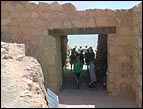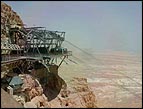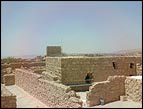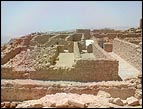TOURING
ISRAEL
Masada:
The Dead Sea Stronghold
By
Craig von Buseck
CBN.com Contributing Writer
CBN.com – Inside:
The Herodian Fortress
King
Herod's Residential Palace The Storehouse
Complex The Roman Bathhouse The
Western Palace The Synagogue Artifacts  View
a slide show from Masada & the Dead Sea View
a slide show from Masada & the Dead Sea
"Brave and loyal
followers! Long ago we resolved to serve neither the Romans nor anyone other than
God Himself, who alone is the true and just Lord of mankind. The time has now
come that bids us prove our determination by our deeds we have never submitted
to slavery, even when it brought no danger with it. We must not choose slavery
now, and with it penalties that will mean the end of everything if we fall alive
into the hands of the Romans God has given us this privilege, that we can die
nobly and as free men and leave this world as free men in company with our wives
and children." -- Excerpts from Ben-Yair's Oration
With these words
the Jewish Zealots, led by Elazar Ben-Yair, who had been encamped in the mountaintop
fortress of Masada, decided to take their own lives, and the lives of their wives
and children, rather than be captured by the Romans. In 72 A.D., three
years after Titus captured Jerusalem and destroyed the Temple, the Roman army
attempted to regain King Herod's military post and palace at Masada on the cliff
top banks of the Dead Sea. Six years earlier, in 66 A.D., at the beginning of
the Great Revolt against Rome, the radical Zealots had established their headquarters
at Masada when they overthrew the Roman garrison that had been stationed there.
At first the Roman commanders had hoped that the besieged people would surrender
due to hunger and thirst. The Roman army numbered some ten to fifteen thousand
men, while the entire besieged population on Masada number 967 people, including
men, women and children.  The
siege lasted several months, during which time the Romans build a massive embankment
on the western slope of the mountain. The Romans climbed this man-made ramp to
attack the Zealots, who were living in the fortress with plenty of food that they
had stored away before the siege -- and a massive supply of water that was collected
naturally in Herod's man-made rain collection system. When the Romans finally
reached the top of the mountain, they set fire to the wood-and-soil wall that
was the last defense of the Zealots at Masada. The Jewish warriors realized that
there was no hope left, and decided to take their own lives rather than to be
captured by the Romans. The
siege lasted several months, during which time the Romans build a massive embankment
on the western slope of the mountain. The Romans climbed this man-made ramp to
attack the Zealots, who were living in the fortress with plenty of food that they
had stored away before the siege -- and a massive supply of water that was collected
naturally in Herod's man-made rain collection system. When the Romans finally
reached the top of the mountain, they set fire to the wood-and-soil wall that
was the last defense of the Zealots at Masada. The Jewish warriors realized that
there was no hope left, and decided to take their own lives rather than to be
captured by the Romans.
The great Hebrew historian of that time, Josephus
Flavius recorded the tragic events that took place as the Romans breached the
Masada defenses:
They [the Zealots] then chose ten men form
amongst them by lot, who would slay all the rest; every one of whom laid himself
down by his wife and children on the ground, and threw his arms about them, and
they offered their necks to the stroke of those who by lot executed that melancholy
office; and when these ten had without fear slain them all, they made the same
rule for casting lots for themselves, and he whose lot it was should first kill
the other nine, and after all, should kill himself and he who was last of all,
examined the mass of those who lay on the ground, and when he had perceived that
they were all slain, he set fire to all corners of the royal palace, and with
the great force of his hand ran his sword into his body up to the hilt, and fell
dead beside his kinsmen. Thus they all died believing that they had left no living
soul behind to bear the Roman yoke The Romans
expected that they should be fought in the morning, accordingly put on their armor
and laid bridges upon their ladders from their banks, to make an assault upon
the fortress... saw nobody as an enemy, but a terrible solitude on every side,
with a fire within the place, as well as perfect silence They were at a loss
to guess at what had happened
 Masada
(Hebrew for fortress), is situated atop an isolated rock cliff at the western
end of the Judean Desert, rising high above the Dead Sea. It is a place of stark,
yet majestic beauty. Masada
(Hebrew for fortress), is situated atop an isolated rock cliff at the western
end of the Judean Desert, rising high above the Dead Sea. It is a place of stark,
yet majestic beauty.
On the east the rock falls in a sheer drop of 450
meters to the Dead Sea (the lowest point on earth, some 400 meters below sea level)
and in the west it stands about 100 meters above the surrounding terrain. The
natural approaches to the cliff top are steep and jagged -- nearly impossible
for an army to climb. The topographical position of Masada, its remoteness
from human habitation, its natural fortifications, and its proximity to the valuable
salt manufacturing of the Dead Sea made it an ideal location for a fortress during
the Second Temple period. Herod the Great, who ruled under Roman patronage, chose
Masada as a place of refuge from potential enemies both at home and abroad. On
the flat top of this rugged mountain he built fortifications and splendid palaces
for himself and his entourage. Josephus described this unique desert cliff garrison
as being "fortified by Heaven and man alike against any enemy who might wage
war against it." After Herod's death, the Roman army continued to occupy Masada
as an important military outpost. But in 66 A.D. as the Jews undertook
the Great Revolt against Rome, a group of Sicarii commanded by Menahem Ben-Yehuda
of Galilee captured Masada from the Roman garrison stationed there. The Sicarii
were a group of Zealot extremists determined to fight against the Romans to the
death -- they were named after the "Sica," a dagger that they carried. During
the years of the Revolt, Masada became a refuge for more Zealots who fled with
their families, as well as for other desperate elements such as the Essenes. Following
the murder of Ben-Yehuda by his opponents in Jerusalem, his surviving followers
fled to Masada -- among them was Menahem's nephew Elazar Ben-Yair, who later became
the commander of the fortress. After the destruction of the Temple in 70 A.D.,
the last rebellious members reached Masada. Designed as a stronghold for
a king, the fortress now became a refuge for the masses, who used various parts
of the palaces as well as thin walled rooms in the casemate wall as their dwellings.
Buildings such as a synagogue, public hall, and ritual-baths were erected. The
nature of the place and the situation made cooperative living arrangements essential.
The only written source about Masada is Josephus Flavius' The Jewish War.
Born Joseph ben Matityahu of a priestly family, he was a young leader at the outbreak
of the Great Jewish Rebellion against Rome (66 CE) when he was appointed governor
of Galilee. He managed to survive the suicide pact of the last defenders of Jodfat
and surrendered to Vespasian (who shortly thereafter was proclaimed emperor) -
events he described in detail. Calling himself Josephus Flavius, he became a Roman
citizen and a successful historian, and his accounts have been proved largely
accurate. According to Josephus, Herod the Great built the fortress of
Masada between 37 and 31 BCE. Herod, an Idumean, had been made King of Judea by
his Roman overlords, and was hated by his Jewish subjects. For all of his excesses
and evil ways, Herod was a master builder, and he "furnished this fortress as
a refuge for himself." It included a casemate wall around the plateau, storehouses,
large cisterns ingeniously filled with rainwater, barracks, palaces and an armory.
 Some
75 years after Herod's death, the Zealots took Masada, and from there they raided
and harassed the Romans for two years. Then, in 73 A.D., the Roman governor Flavius
Silva marched against Masada with the Tenth Legion, auxiliary units, and thousands
of Jewish prisoners-of-war. The Romans established camps at the base of Masada
and laid siege to it. They then constructed a rampart of thousands of tons of
stones and beaten earth against the western approaches of the fortress and in
the spring of the year 74 A.D. moved a battering ram up the ramp and breached
the wall of the fortress. Some
75 years after Herod's death, the Zealots took Masada, and from there they raided
and harassed the Romans for two years. Then, in 73 A.D., the Roman governor Flavius
Silva marched against Masada with the Tenth Legion, auxiliary units, and thousands
of Jewish prisoners-of-war. The Romans established camps at the base of Masada
and laid siege to it. They then constructed a rampart of thousands of tons of
stones and beaten earth against the western approaches of the fortress and in
the spring of the year 74 A.D. moved a battering ram up the ramp and breached
the wall of the fortress.
Josephus Flavius dramatically recounts the story
told him by two surviving women. The defenders - almost one thousand men, women
and children - led by Eleazar ben Ya'ir, decided to burn the fortress and end
their own lives, rather than be taken alive. "And so met (the Romans) with the
multitude of the slain, but could take no pleasure in the fact, though it were
done to their enemies. Nor could they do other than wonder at the courage of their
resolution, and at the immovable contempt of death which so great a number of
them had shown, when they went through with such an action as that was." Following
the tragic death of the Zealots, Masada fell back into Roman hands, and was occupied
by them for many years. Eventually the Romans abandoned this remote outpost
and it lay desolate and uninhabited for hundreds of years. In the 5th and 6th
centuries a few Byzantine Christian monks settled there. They adapted a number
of caves as dwellings, and built cells in a number of places in or near the ruined
buildings. They also erected a church close to the ruins of the western palace.
They and their successors stayed for more than a hundred years. When they finally
left, Masada became desolate once again -- and remained so for centuries. The
heroic story of Masada and its dramatic end attracted many explorers to the Judean
desert in attempts to locate the remains of the fortress. The site was identified
in 1842, but intensive excavations took place only in 1963-65, with the help of
hundreds of enthusiastic volunteers from Israel and from many foreign countries,
eager to participate in this exciting archeological venture. To them, and to Israelis,
Masada symbolizes the determination of the Jewish people to be free in its own
land. The Herodian Fortress (Material
from the following is exerpted from the Israeli Ministry of Foreign Affairs).
The flat plateau of Masada measures 600 x 300 meters. The casemate wall (two parallel
walls with partitions dividing the space between them into rooms), is 1,400 meters
long and 4 meters wide. It was built along the edge of the plateau, above the
steep cliffs, and it had many towers. Three narrow, winding paths led from below
to fortified gates. The water supply was guaranteed by a network of large, rock-hewn
cisterns on the northwestern side of the hill. They filled during the winter with
rainwater flowing in streams from the mountain on this side. Cisterns on the summit
supplied the immediate needs of the residents of Masada and could be relied upon
in time of siege. To maintain interior coolness in the hot and dry climate
of Masada, the many buildings of various sizes and functions had thick walls constructed
of layers of hard dolomite stone, covered with plaster. The higher northern side
of Masada was densely built up with structures serving as the administrative center
of the fortress. This section included storehouses, a large bathhouse and comfortable
living quarters for officials and their families. King
Herod's Residential Palace On the northern edge of the steep cliff,
with a spectacular view of the Dead Sea and the vast desert wasteland, stood King
Herod's elegant, intimate, private palace. It was separated from the fortress
by a wall, affording total privacy and security. This northern palace consisted
of three terraces, luxuriously built, with a narrow, rock-cut staircase connecting
them. On the upper terrace, several rooms served as living quarters; in front
of them is a semi-circular balcony with two concentric rows of columns. The rooms
were paved with black and white mosaics in geometric patterns. The two
lower terraces were intended for entertainment and relaxation. The middle terrace
had two concentric walls with columns, covered by a roof; this created a portico
around a central courtyard. The lowest, square terrace has an open central courtyard,
surrounded by porticos. Its columns were covered with fluted plaster and supported
Corinthian capitals. The lower parts of the walls were covered in frescos of multicolored
geometrical patterns or painted in imitation of cut marble. On this terrace
was also a small private bathhouse. Here, under a thick layer of debris, were
found the remains of three skeletons, of a man, a woman and a child. The beautifully
braided hair of the woman was preserved, and her sandals were found intact next
to her; also hundreds of small, bronze scales of the man's armor, probably booty
taken from the Romans. The Storehouse
Complex  This
consisted of two rows of long halls opening onto a central corridor. The floor
of the storerooms was covered with thick plaster and the roofing consisted of
wooden beams covered with hard plaster. Here, large numbers of broken storage
jars, which once contained large quantities of oil, wine, grains, and other foods
were found. This
consisted of two rows of long halls opening onto a central corridor. The floor
of the storerooms was covered with thick plaster and the roofing consisted of
wooden beams covered with hard plaster. Here, large numbers of broken storage
jars, which once contained large quantities of oil, wine, grains, and other foods
were found.
The Roman
Bathhouse Elaborately built, the Roman bathhouse probably served the
guests and senior officials of Masada. It consisted of a large courtyard surrounded
by porticos and several rooms, all with mosaic or tiled floors and some with frescoed
walls. The largest of the rooms was the hot room (caldarium). Its suspended
floor was supported by rows of low pillars, making it possible to blow hot air
from the furnace outside, under the floor and through clay pipes along the walls,
to heat the room to the desired temperature. The
Western Palace This is the largest building on Masada, covering over
4,000 square meters (one acre). Located along the center of the western casemate
wall, near the main gate towards Judea and Jerusalem, it served as the main administration
center of the fortress, as well as the king's ceremonial palace. It consisted
of four wings: an elaborate royal apartment, a service and workshop section, storerooms,
and an administrative unit. In the royal apartment, many rooms were built around
a central courtyard. On its southern side was a large room with two Ionic columns
supporting the roof over the wide opening into the courtyard. Its walls were decorated
with molded panels of white stucco. On the eastern side were several rooms
with splendid colored mosaic floors. One of these, the largest room, has a particularly
decorative mosaic floor with floral and geometric patterns within several concentric
square bands. This room may have been King Herod's throne room, the seat of authority
when he was in residence at Masada. The
Synagogue Part of the Herodian construction was a large hall incorporated
into the northwestern section of the casemate wall and oriented towards Jerusalem.
This large hall became the synagogue for the Zealots who lived in Masada during
the Revolt. They built four tiers of plastered benches along the walls, as well
as columns to support its ceiling. This synagogue is considered to be the best
example of the early synagogues, those predating the destruction of the Temple
of Jerusalem in 70 A.D. An ostracon bearing the inscription me'aser kohen
(tithe for the priest) was found in the synagogue. Also, fragments of two scrolls,
parts of Deuteronomy and Ezekiel 37, including the vision of the "dry bones,"
were found hidden in pits dug under the floor of a small room built inside the
synagogue. Artifacts Among
the many small finds - most from the occupation period of the zealots - were pottery
and stone vessels, weapons (mainly arrowheads), remnants of textiles, and foodstuffs
preserved in the dry climate of this area; also hundreds of pottery sherds, some
with Hebrew lettering, coins and shekels. Of special interest among the
postherds of amphora used for the importation of wine from Rome (inscribed with
the name C. Sentius Saturninus, consul for the year 19 B.C.), is one bearing the
inscription: To Herod King of the Jews. Several hoards of bronze
coins and dozens of silver shekels and half-shekels had been hidden by the zealots;
the shekalim were found in superb condition and represent all the years of the
Revolt, from year one to the very rare year 5 (70 A.D.), when the Temple was destroyed.
In the area in front of the northern palace, eleven small ostraca were
uncovered, each bearing a single name. One reads "ben Yai'r" and could be short
for Eleazar ben Ya'ir, the commander of the fortress. It has been suggested that
the other ten names are those of the men chosen by lot to kill the others and
then themselves, as recounted by Josephus. Evidence of a great conflagration
was found everywhere. According to Josephus, the last of the Zealots set the fire
before he committed suicide. Josephus writes that everything was burnt except
the stores - to let the Romans know that it was not hunger that led the defenders
to suicide. Two thousand years have passed since the fall of Masada. The
climate of the region and its remoteness has helped to preserve its remains to
an extraordinary degree. Today, a modern cable car carries the many visitors to
the top of the rock with its breathtaking view across the Dead Sea, where the
last Jewish stronghold against Rome stood. Masada National Park is open
all year round (excluding Yom Kippur) from sunrise to one hour before sunset.
The cable car operates throughout the year (excluding Yom Kippur) from 8 a.m.
until 4 p.m. On Friday nights and holidays operations end one hour before the
park is closed. More
from Tour Israel with CBN.com
 Craig
von Buseck is Ministries Director of CBN.com. Send
him your comments on this article. More from Craig on CBN.com. Craig
von Buseck is Ministries Director of CBN.com. Send
him your comments on this article. More from Craig on CBN.com.
CBN IS HERE FOR YOU!
Are you seeking answers in life? Are you hurting?
Are you facing a difficult situation?
A caring friend will be there to pray with you in your time of need.
|